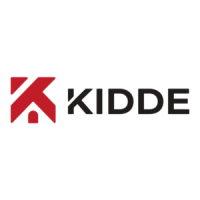Hazardous Location
Devices
Initiating Devices p. 36
Notification Appliances p. 37
Classes
Class I - Hazardous Gases. Class I locations are areas in which flam-
mable gases or vapors are or may be present in the air in quantities
sufficient to produce explosive or ignitable mixtures.
Typical Class I Hazardous Areas
• Spray painting and nishing areas
• Utility gas plants
• Petroleum rening production plants
• Petroleum dispensing locations
• Dry cleaning facilities
• Dip tanks containing combustibles or ammable liquids
• Plant facilities extracting solvents
• Inhalation anesthetics areas
• Process facilities manufacturing pyroxylin type plastics
Class II - Hazardous Dusts. Class II locations represent areas that are
hazardous due to the presence of combustible dust.
Typical Class II Hazardous Areas
• Flour mills
• Feed mills
• Grain elevators and grain handling facilities
• Aluminum manufacturing and storage areas
• Magnesium manufacturing and storage areas
• Coal preparation and handling facilities
• Starch manufacturing and storage areas
• Confectionery plants
• Pulverizer sugar and cocoa manufacturing, and storage plants
• Spice grinding and storage plants
Class III - Hazardous Fibers. Class III locations have easily ignitable
bers or yings present, but not likely to be suspended in air in quantities
sufficient to produce ignitable mixtures in the atmosphere.
Typical Class III Hazardous Areas
• Textile mills
• Woodworking plants*
• Furniture manufacturers*
• Cotton gins
• Cotton seed milling plants
• Flax plants
• Carpet manufacturers
* Except if wood flour (dust), which is Class II Group G, is present
Divisions
The Location Classes are broken down by the NFPA into
Divisions 1 and 2, dening different levels of risk. In general,
the risk of there being a hazardous presence of ammable/
combustible/ignitable materials is higher for Division 1 than
for Division 2. The specics differ between the three classes
(I, II and III). Equipment suitable for Division 1 is also suitable
for Division 2 locations.
Groups
Class I and II locations are divided by the NFPA into Group
designations identifying specic gases, vapors and dusts by
characteristic similarities that relate to specific equipment
construction requirements. Class III locations are not divided
into separate group designations.
Class I Groups
Group A. Atmospheres containing acetylene.
Group B. Atmospheres containing hydrogen, fuel and
combustible process gases containing more than 30 percent
hydrogen by volume, or gases or vapors of equivalent hazard
such as butadiene, ethylene oxide, propylene oxide, and
acrolein.
Group C. Atmospheres such as ethyl ether, ethylene, or
other gases or vapors of equivalent hazard.
Group D. Atmospheres containing acetone, ammonia,
benzene, butane, cyclopropane, ethanol, gasoline, hexane,
methanol, methane, natural gas, naphtha (petroleum), pro-
pane, or gases or vapors of equivalent hazard.
Class II Groups
Group E. Atmospheres containing combustible metal dusts,
including aluminum, magnesium, and their commercial
alloys, or other combustible dusts whose particle size, abra-
siveness and conductivity present similar hazards in the use
of electrical equipment.
Group F. Atmospheres containing combustible carbona-
ceous dusts, including carbon black, charcoal, coal, or dusts
that have been sensitized by other materials so that they
present an explosion hazard.
Group G. Atmospheres containing combustible dusts not
included in Group E or F, including our, grain, wood, plastic,
and chemicals.
Kidde hazardous location devices provide reliable life safety protection and emergency signaling in areas where
atmospheres could become harsh or explosive. All hazardous location devices are UL rated under the full range of
classications set out in the National Electrical Code.
The following classication denitions are an interpretive summary based on the 1996 edition of the National Elec-
trical Code (NEC, NFPA 70). Refer to the latest editions of NFPA 497M, NFPA 70 and the UL Hazardous Location
Equipment Directory for current and more detailed information. For more information on NEMA classications, refer
to NEMA Standards Publication No. 250.
Hazardous Location Classifications
Hazardous Location Devices
Hazardous Location
Devices
Door Holders
& Relays
35
VM
Hazardous Location Devices
SERIES

